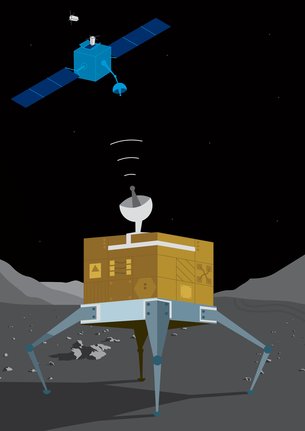21.09.2017
FIRST STEPS: RETURNING HUMANITY TO THE MOON
In the first act of lunar exploration, Neil Armstrong and Buzz Aldrin were major characters. In setting its sights on the Moon, ESA hopes to bring many more actors to this off-world stage.
By testing the market for transport services to the Moon, ESA aims to push the limits of technology and create new models of space business.
Touching down on the Moon was a monumental moment in human history. Eight short years and enormous resources took humankind to the lunar surface, initially for less than one day. Those small steps for humanity, and the missions that followed, taught us much about the Moon, our cosmic time capsule. But humans have not returned since Apollo 17 departed in 1972.
Today’s technology could easily get us back to the Moon, but it is still expensive to develop the ride and take everything needed to support life with us. ESA wants our return to the Moon to be sustainable and based on partnerships – not only with international space agencies but also with business. A commercial approach may just be the ticket – literally and figuratively – to making it happen.
Rather than develop a complete lander mission from scratch – a long and costly process – ESA wants to buy a ride on a commercial lander to deliver our precious research equipment safely to the surface. Once there, we are ready to pay the ‘roaming charges’ to talk to our hardware.
But for our return to the Moon to be truly sustainable, we must make use of lunar resources. So in addition to transportation and communication, we are looking to invest in the development and pay for the use of technology that can turn indigenous lunar material into oxygen and water, critical resources for sustaining future human operations in deep space.
Why the emphasis on sustainability? If been there, done that were the sole definition of exploration, then setting our sights only on more remote parts of our Solar System would make sense. But while we learned a lot about the Moon from Apollo, we literally just scratched the surface of Earth’s eighth continent.
Satellites orbiting the Moon have since revealed the presence of oxygen and water ice. These are potential usable resources for our spacefaring future.
Shape the next act
ESA is inviting service providers with the right ideas to take part in a one-year study that will shape this In-Situ Resource Utilisation Demonstrator Mission. We want to hear what commercial partners need from us and share what we expect from them.
Together, we want to explore what it would mean to make lunar exploration a viable, competitive, and, most importantly, sustainable endeavour.
We want to go back to the Moon to crack its mysteries and use it as a springboard towards humanity’s future in deep space. If you are a commercial enterprise ready to take on the challenge and build on the legacy of Neil and Buzz, then we want to hear from you.
Quelle: ESA



